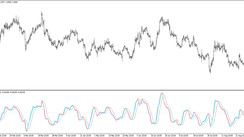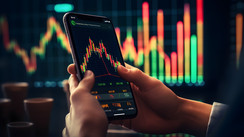In the tempestuous aftermath of the Great Recession in 2008 and 2009, central banks worldwide embarked on a new, largely uncharted voyage. They embraced a strategy known as quantitative easing, an innovative tool involving the long-term acquisition of assets such as Treasury bonds and mortgage-backed securities (MBS).
This method serves as an emergency conduit, flooding the financial system with liquidity and providing a lifeline for central banks trying to prevent a total collapse of the banking system. By unlocking this cascade of cash, the aim is to significantly reduce interest rates and reinvigorate economic growth.
Spearheading this endeavor, the U.S. Federal Reserve initiated securities purchasing in 2009. As a direct outcome, interest rates dipped dramatically, and correspondingly, so did the U.S. dollar. In the twilight preceding the launch of QE1, the U.S. dollar index (DXY) experienced a precipitous 10% drop — the most substantial monthly plunge in over a decade.
Pandemic Paradoxes: Overheating Economies in a Stalled World
As we traversed into the heart of the year 2020, the world found itself in the unyielding grip of the COVID-19 pandemic. As a novel virus stormed across the globe, it brought about an array of contradictory and complex economic phenomena that seemed to clash against the backdrop of a world largely at a standstill. This tumultuous era, fraught with uncertainty, presented an intricate tapestry woven from a myriad of challenging factors. Let's unravel this complex skein to understand the different threads that contributed to the paradox of an overheating economy in a world otherwise stalled:
-
The lockdown labyrinth: A significant portion of the global population found themselves subject to stringent COVID-19 lockdowns. These were necessary measures aimed at stemming the viral spread, but they also imposed an almost artificial coma on a considerable chunk of the global economy. Closed businesses, halted services, and stifled consumer activity were the hallmarks of this period.
-
The disrupted supply chain: As countries went into lockdown, the intricate global network of supply chains started to fracture. Goods struggled to reach their destinations, raw materials lay idle, and production lines fell silent. This disruption caused significant economic ripple effects, contributing to inflationary pressures and threatening the smooth running of industries worldwide.
-
The oil market oddities: The oil markets weren't immune to the pandemic's widespread fallout. A bizarre combination of plummeting demand and an initial oversupply led to wild price fluctuations. The oil market's aberrations were a symptom of broader economic dysfunction, adding another layer to the convoluted economic picture.
-
Employment enigma – The Great Resignation: In an unexpected twist, the pandemic spurred a significant shift in the job market. Coined as "The Great Resignation," millions chose to leave their jobs, voluntarily opting out of the workforce. This mass exodus, against the backdrop of an economically unstable era, left employers scrambling and further fuelled economic anomalies.
-
Aggressive monetary policy response: The Federal Reserve, recognizing the looming threat of economic disaster, responded with an assertive tightening of monetary policy. The aim was to counteract the effects of the pandemic, but this also stoked the flames of an already overheating economy.
This unique confluence of challenges brewed an illusionary cocktail of an economy threatening to spin out of control. At a time when large segments of the world were under lockdown, and conventional wisdom would suggest economic slowdown, economies seemed to race at breakneck speed, ready to overheat.
Despite the contrasting backdrop, economists and policymakers had spent the prior decade wrestling with a very different beast — the specter of an economy slowing down. Their primary concern was that the Federal Reserve was under-armed in the face of a slowing economy. Interest rates were near-zero, and the only weapons left in the arsenal appeared to be meddling with the currency or leveraging the still somewhat unfamiliar concept of quantitative easing (QE). Little did they realize, a global pandemic would soon test the strength of these tools.
Currency Manipulation: An Intricate and Controversial Tool
Navigating the world of currency manipulation is like traversing a convoluted maze—it's complex, often unclear, and filled with contentious debate. Yet, it remains a crucial tool in a nation's economic arsenal. So, let's delve into the labyrinth and understand what exactly makes currency manipulation so controversial and complex:
-
Defining the indefinable: As a Wall Street Journal blog post cleverly phrased it, “Currency manipulation is not like pornography—you don’t know it when you think you see it.” Indeed, currency manipulation is a subtle art. A policy action that favorably impacts a nation's exchange rate—making its exports more competitive—is not in itself indicative of currency manipulation. The test lies in proving that the currency's value is being held artificially below its actual worth. However, discerning a currency’s true value is an equally challenging feat.
-
The allure of a weakened currency: Generally, nations prefer a weakened currency. This may seem counterintuitive at first, but when we delve deeper, the benefits become clear:
- Boosting exports: A weaker currency reduces the cost of a nation's exports, making them more competitive on the international market. To illustrate, a weak U.S. dollar renders U.S. car exports more affordable for foreign buyers.
- Reducing trade deficits: By enhancing export competitiveness, a weaker currency can help a nation shrink its trade deficit.
- Easing debt obligations: A weaker currency can also alleviate the pressures of a nation's sovereign debt obligations. When debt is denominated in a foreign currency, a weak local currency effectively decreases the cost of debt payments.
-
Manipulation mechanisms: Nations employ different strategies to keep their currency values low. Take China's yuan, for instance. Every morning, the People's Bank of China (PBOC) sets the yuan's rate, and it doesn’t allow its currency to trade outside a set band for the next 24 hours. This strategy wards off significant intraday declines.
-
Direct intervention: There is another, more direct, form of currency manipulation—intervention. During the financial crisis, when the Swiss franc appreciated considerably, the Swiss National Bank implemented a strategy of buying large amounts of foreign currency (primarily USD and euros) and selling francs. This direct market intervention aimed to lower the franc's value, thereby increasing Switzerland's trade position within Europe.
Interestingly, some commentators argue that there is yet another form of currency manipulation, albeit a more indirect one: quantitative easing. This assertion leads us to an intriguing crossroads where the worlds of currency manipulation and quantitative easing intersect, fostering a hotbed for lively economic debate.
The Intersection of Quantitative Easing and Currency Manipulation
Stepping into the world of quantitative easing (QE) is akin to venturing into uncharted waters. This unconventional monetary policy, which initially seems to exist in a separate realm from currency manipulation, finds surprising intersections that provoke thought-provoking debates.
-
Understanding Quantitative Easing (QE): QE is merely an extension of the everyday function of open market operations (OMO)—a regular mechanism where a central bank expands or contracts the money supply by buying or selling government securities in the open market. The objective of such activities is to reach a specified target for short-term interest rates, which subsequently impacts all other interest rates within the economy.
-
QE: A Recession Response: QE becomes a viable strategy when the economy grapples with a recession, and conventional expansionary open market operations falter. For instance, when interest rates bottomed out during the recession, the Federal Reserve launched three rounds of QE, adding over $3.5 trillion to its balance sheet by October 2014. This massive stimulus, intended to invigorate the domestic economy, also exerted indirect influences on the exchange rate, pushing the dollar downwards.
-
QE's Impact on Exports: The depreciation of the dollar wasn't entirely unwelcome. A weaker dollar made exports cheaper, which, in turn, could stimulate economic growth. However, this maneuver also drew criticisms from international policymakers, who argued that a weakened U.S. dollar undermined their exports. This contentious scenario incited a fresh question—Is QE essentially a form of currency manipulation?
While the Federal Reserve deliberately embarked on a monetary policy that depreciated its currency, the primary aim was to slash domestic interest rates to stimulate borrowing and, consequently, spending. The tangential impact of the currency's devaluation was merely a byproduct of implementing a flexible exchange-rate system.
The Verdict: Currency Manipulation vs. Quantitative Easing
In the grand scheme of economic strategies, currency manipulation and quantitative easing might appear as different sides of the same coin—one is focused on interest rate policy, while the other has a currency-centric approach. However, as central banks embarked on their QE programs, an unexpected outcome was the weakening of their currencies.
This effect—intentional or otherwise—invites the argument that QE, in some respects, can be considered a form of currency engineering. However, whether it strays into the realm of manipulation remains an enduring debate, subject to the ever-evolving dynamics of economic theory and practice.
In the final analysis, while there is a fine line separating currency manipulation and quantitative easing, their intersections have sparked some of the most enlightening conversations in the world of finance. Whether they are complementary tools, competing strategies, or distinct elements of a larger economic puzzle continues to captivate economists, policymakers, and finance enthusiasts worldwide.





